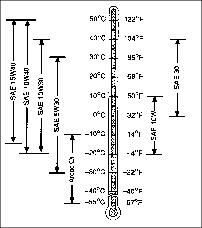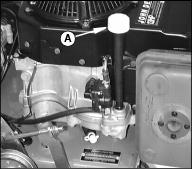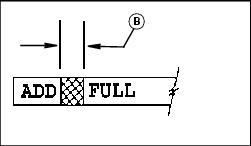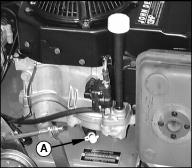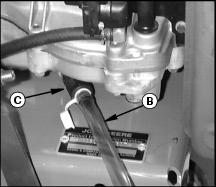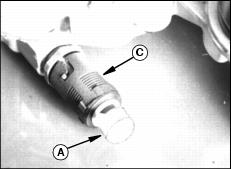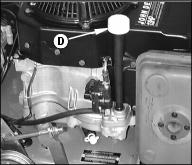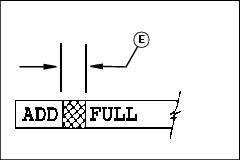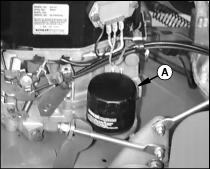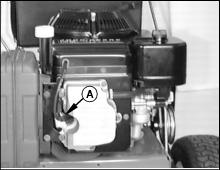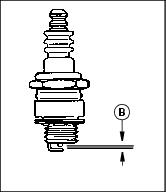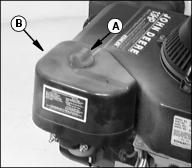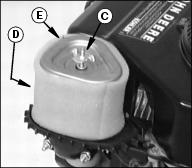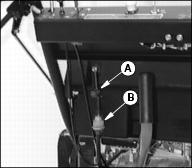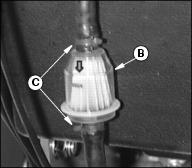
Service Engine
Avoid Fumes
· If it is necessary to run an engine in an enclosed area, use an exhaust pipe extension to remove the fumes. |
Engine Oil
Use oil viscosity based on the expected air temperature range during the period between oil changes.
The following oil is preferred:
Other oils may be used if they meet one of the following:
· API Service Classification SG
· API Service Classification SF
Oils meeting Military Specification MIL-L-46167B may be used as arctic oils.
Checking Engine Oil Level
Service Interval: Check oil level on a daily basis.
1. Park mower on a level surface. Stop engine.
2. Remove dipstick (A). Wipe it clean.
3. Install dipstick in tube, but DO NOT tighten it. Let dipstick threads rest on top of tube, rotate cap counterclockwise until it "clicks" or drops into the thread lead.
4. Remove dipstick. Check oil level on dipstick; oil should be between ADD and FULL (B).
5. Add oil if necessary. (See Engine Oil in this section for correct oil.)
6. Install and tighten dipstick.
Changing Engine Oil
IMPORTANT: Avoid damage! To help prevent damage to engine: · Change oil and filter after first 25 hours of operation. (See Service Interval Chart for remaining intervals.) |
2. Park mower on a level surface.
3. Stop engine and remove key.
· Attach hose (B) to drain valve.
· Push drain valve (C) in, turn to the left and pull drain valve out to open valve.
· Drain oil into oil drain pan.
· Close drain valve by pushing in and turning valve to the right.
· Remove hose (B) and install drain cap (A).
7. Add oil slowly into dipstick tube. (See Engine Oil in this section for correct oil.)
Approximate Crankcase Capacity
8. Install dipstick, but DO NOT tighten. Let dipstick threads rest on top of tube, rotate cap counter -clockwise until it "clicks" or drops into the thread lead.
9. Remove dipstick. Check oil level on dipstick; oil level must be between ADD and FULL (E).
10. Install and tighten dipstick.
11. Start engine and check for oil leaks. Correct any leaks before operating.
Changing Engine Oil Filter
IMPORTANT: Avoid damage! To help prevent damage to engine, change oil and filter after first 25 hours of operation. (See Service Interval Chart for remaining intervals.) |
· Put small container under filter to catch draining oil.
· Turn filter counterclockwise to remove it.
· Remove rubber seal with filter.
2. Put film of clean engine oil on seal of new filter.
· Turn filter until seal contacts mounting surface.
· Then turn filter BY HAND 1/2 turn more.
4. Run engine to fill filter with oil and check for oil leaks.
5. Check oil level, add oil as required. (See Engine Oil in this section for correct oil.)
Cleaning And Gapping Spark Plug
Service Interval: Clean and gap spark plug every 100 hours of operation.
1. Clean area around spark plug.
2. Disconnect spark plug wire (A).
3. Remove and inspect spark plug:
· Clean plug and check for damage, replace if necessary.
· If plug is in good condition, check gap.
4. Check and adjust spark plug gap (B):
5. Install spark plug and tighten to 40 N·m (30 lb-ft.).
Adjusting Carburetor
NOTE: The carburetor is calibrated by the engine manufacturer and should not require any adjustments.
NOTE: If engine is operated at altitudes above 1829 m
(6,000 ft.), some carburetors may require a special high altitude main jet. See your John Deere dealer.
NOTE: Possible engine surging will occur at high rpm when the transmission is in neutral ("N") and the PTO switch is in the OFF position. This is a normal condition due to the emission control system.
If engine is hard to start or runs rough, check the Troubleshooting section of this manual.
After performing the checks in the troubleshooting section and your engine is still not performing correctly, contact your John Deere dealer.
Checking And Cleaning Air Cleaner
· Operating in dusty conditions may require daily maintenance.
· Foam Precleaner - Check daily, clean every 25 hours of operation.
· Paper Element - Inspect weekly, clean or replace every 100 hours of operation.
1. Loosen wingnut (A) and remove air cleaner cover (B).
2. Remove wingnut (C) to remove air filter elements.
3. Foam Precleaner (D) - Check daily, clean every 25 hours of operation:
· Wash in detergent and water.
· Saturate in clean engine oil and squeeze out excess.
4. Paper element (E) - Inspect weekly, clean or replace every 100 hours of operation:
· If paper element is dirty, tap gently on your hand to remove dust.
· If paper element is extremely dirty, install new element.
Replacing Fuel Filter
Keep cigarettes, sparks, and flames away from the fuel system. Make sure engine is cool to the touch. |
· Operating in dirty conditions may require more maintenance.
· Replace fuel filter every 100 hours of operation or annually.
1. Park tractor on a level surface.
3. Turn fuel shut-off valve (A) to the CLOSED (OFF) position. (See Fuel Shut-Off Valve in Operating section.)
4. Slide hose clamps (C) away from filter (B).
5. Place a drain pan under hoses to catch any fuel that maybe left in the hoses.
6. Disconnect hoses from filter.
7. Install new filter. Be sure filter is located with arrow pointing in direction of fuel flow.
8. Connect hoses to new filter.
10. Turn fuel shut-off valve (A) to the OPEN (ON) position. (See Fuel Shut-Off Valve in Operating section.)
